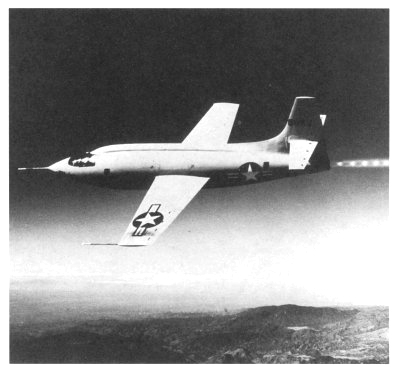 |
| The Bell X-1. (NASA photo) |
Research in Supersonic Flight and
the Breaking of the Sound Barrier
by John D. Anderson, Jr.
"We call the speed range just below and just above the sonic speed-Mach number nearly equal to 1-the transonic range. Dryden [Hugh Dryden, well-known fluid dynamicist and past administrator of the National Advisory Committee for Aeronautics] and I invented the word 'transonic' We had found that a word was needed to denote the critical speed range of which we were talking. We could not agree whether it should be written with one s or two. Dryden was logical and wanted two s's. I thought it wasn't necessary always to be logical in aeronautics, so I wrote it with one s. I introduced the term in this form in a report to the Air Force. I am not sure whether the general who read it knew what it meant, but his answer contained the word, so it seemed to be officially accepted. . . . I will remember this period (about 1941) when designers were rather frantic because of the unexpected difficulties of transonic flight. They thought the troubles indicated a failure in aerodynamic theory. "1
The morning of Tuesday, October 14, 1947, dawned bright and beautiful
over the Muroc Dry Lake, a large expanse of flat, hard lake bed in the
Mojave Desert in California. Beginning at 6:00 a.m., teams of engineers
and technicians at the Muroc Army Air Field readied a small rocket-powered
airplane for flight. Painted orange, and resembling a 50-caliber machine
gun bullet mated to a pair of straight, stubby wings, they carefully installed
the Bell X-1 research vehicle in the bomb bay of a four-engine B-29 bomber
of World War II vintage. At 10:00 a.m., the B-29 with its soon-to-be historic
cargo took off and climbed to an altitude of 20,000 feet. As it passed
through 5,000 feet, Captain Charles E. (Chuck) Yeager, a veteran P-51 pilot
from the European theater during World War II, struggled into the cockpit
of the X-1. This morning Yeager was in pain from two broken ribs incurred
during a horseback riding accident the previous weekend. However, not wishing
to disrupt the events of the day, Yeager informed no one at Muroc about
his condition, except his close friend Captain Jack Ridley, who helped
him to squeeze into the X-1 cockpit. At 10:26 a.m., at a speed of 250 miles
per hour, the brightly painted X-1 dropped free from the bomb bay of the
B-29. Yeager fired his Reaction Motors XLR-11 rocket engine and, powered
by 6,000 pounds of thrust, the sleek airplane accelerated and climbed rapidly.
Trailing an exhaust jet of shock diamonds from the four convergent-divergent
rocket nozzles of the engine, the X-1 soon approached Mach 0.85, the speed
beyond which there existed no wind tunnel data on the problems of transonic
flight in 1947. Entering this unknown regime, Yeager momentarily shut down
two of the four rocket chambers, and carefully tested the controls of the
X-1 as the Mach meter in the cockpit registered 0.95 and increased still.
Small invisible shockwaves danced back and forth over the top surface of
the wings. At an altitude of 40,000 feet, the X-1 finally started to level
off, and Yeager fired one of the two shutdown rocket chambers. The Mach
meter moved smoothly through 0.98, 0.99, to 1.02. Here, the meter hesitated
then jumped to
1. Theodore von Kármán, Aerodynamics (Ithaca, NY: Cornell University Press, 1954), p. 116.
59
60 RESEARCH IN SUPERSONIC FLIGHT AND THE BREAKING OF THE SOUND BARRIER
1.06. A stronger bow shockwave now formed in the air ahead of the needlelike
nose of the X-1 as Yeager reached a velocity of 700 miles per hour, Mach
1.06, at 43,000 feet. The flight was smooth; there was no violent buffeting
of the airplane and no loss of control as feared by some engineers. At
this moment, Chuck Yeager became the first pilot to fly faster than the
speed of sound, and the small but beautiful Bell X-1, became the first
successful supersonic airplane in the history of flight.2
 |
| The Bell X-1. (NASA photo) |
2. This description of the first supersonic flight is excerpted from John D. Anderson, Jr., Modern Compressible Flow: With Historical Perspective (New York, NY. McGraw-Hill Book Co., 1990 2d ed.), pp. 2-4. For a general reference, from Chuck Yeager's point of view, see General Chuck Yeager and Leo Janos, Yeager.- An Autobiography (New York, NY: Bantam Press, 1985). For a definitive history of the circumstances leading tip to and surrounding the development and flight testing of the Bell X-1, see Richard P. Hallion, Supersonic Flight (New York, NY. Macmillan, 1972).
FROM ENGINEERING SCIENCE TO BIG SCIENCE 61
As the sonic boom from the X-1 propagated across the California desert, this flight became the most significant milestone in aviation since the Wright brothers' epochal first flight at Kill Devil Hills fourty-four years earlier. But in the history of human intellectual accomplishment, this flight was even more significant; it represented the culmination of 260 years of research into the mysteries of high-speed gas dynamics and aerodynamics. In particular, it represented the fruition of twenty-three years of insightful research in high speed aerodynamics carried out by the National Advisory Committee for Aerodynamics (NACA) research that represented one of the most important stories in the history of aeronautical engineering. The purpose of this chapter is to tell this story. The contribution by the NACA to the Bell X-1 was much more technical than it was administrative. Therefore, this chapter will highlight the history of that technology.
The NACA's work on high-speed aerodynamics described in this chapter is also one of the early examples in the history of aerodynamics where engineering science played a deciding role. Beginning in 1919, the NACA embarked on a systematic intellectual quest to obtain the knowledge required to eventually design proper high-speed airfoil shapes. Historian James R. Hansen, in his chapter on the NACA low-drag engine cowling, in the present book, asks the following question about the cowling work: Was it science, or was it engineering? He comes to the conclusion that it was somewhere in between that it was an example of engineering science in action at the NACA. In arriving at this conclusion, Hansen draws from the thoughts in Walter Vincenti's book, What Engineers Know and How They Know It, where Vincenti clearly makes the following distinction between science and engineering: science is the quest for new knowledge for the sake of enhancing understanding, and engineering is a self-standing body of knowledge (separate from science) for the sake of designing artifacts. For the purpose of the present chapter, I suggest this definition of engineering science: Engineering science is the search for new scientific knowledge for the explicit purpose of (1) Providing a qualitative understanding which allows the more efficient design of an engineering artifact, and/or (2) Providing a quantitative (predictive) technique, based on science, for the more efficient design of an engineering artifact. In this chapter we will see that NACA researchers in the 1920s and 1930s were working hard to discover the scientific secrets of high-speed aerodynamics just so they could properly design airfoils for highspeed flight truly engineering science in action. Also, within the general framework of the historical evolution of aerodynamic thought over the centuries, the NACA's highspeed research program is among the earliest examples of engineering science, although that label had not yet been coined at the time.
The Prehistory of High-Speed Flight: Point and
Counterpoint
Most golfers know the following rule of thumb: When you see a flash of lightning in the distance, start counting at a normal rate one, two, three.... For every count of five before you hear the thunder, the lightning bolt struck a mile away. Clearly, sound travels through air at a definite speed, much slower than the speed of light. The standard sea level speed of sound is 1, 117 feet per second in five seconds a sound wave will travel 5,585 feet, slightly more than a mile. This is the basis for the golfer's "count of five" rule of thumb.
The speed of sound is one of the most important quantities in aerodynamics; it is the dividing line between subsonic flight (speeds less than that of sound) and supersonic flight (speeds greater than that of sound). The Mach number is the ratio of the speed of a gas to the speed of sound in that gas. If the Mach number is 0.5, the gas flow velocity is one-half the speed of sound; a Mach number of 2.0 means that the flow velocity is twice
62 RESEARCH IN SUPERSONIC FLIGHT AND THE BREAKING OF THE SOUND BARRIER
that of sound. The physics of a subsonic flow is totally different from that of a supersonic flow a contrast as striking as that between day and night. This is why the first supersonic flight of the X-1 was so dramatic, and why the precise value of the speed of sound is so important in aerodynamics.
Knowledge of the speed of sound is not a product of twentieth century science. Precisely 260 years before the first supersonic flight of the X-1, Isaac Newton published the first calculation of the speed of sound in air. At that time it was clearly appreciated that sound propagated through air at some finite velocity. Newton knew that artillery tests had already indicated that the speed of sound was approximately 1,140 feet per second. The seventeenth century artillery men were preceding the modern golfer's experience; the tests were performed by standing a known large distance away from a cannon, and noting the time delay between the light flash from the muzzle and the sound of the discharge. In Proposition 50, Book II of his Principia (1687), Newton calculated a value of 979 feet per second for the speed of sound in air fifteen percent lower than the existing artillery data. Undaunted, Newton followed a now familiar ploy of theoreticians; he proceeded to explain away the difference by the existence of solid dust particles and water vapor in the atmosphere. However, in reality Newton had made the incorrect assumption in his analysis that the air temperature inside a sound wave was constant (an isothermal process), which caused him to underpredict the speed of sound. This misconception was corrected more than a century later by the famous French mathematician, Pierre Simon Marquis de Laplace, who properly assumed that a sound wave is adiabatic (no heat loss), not isothermal.3 Therefore, by the time of the demise of Napoleon, the process and equation for the speed of sound in a gas was fully understood.
This is not to say that the precise value of the speed of sound was totally agreed upon. The debate lasted well into the twentieth century. Indeed, although this event is little known today, the NACA was an arbiter in setting the standard sea level speed of sound. On October 12, 1943, twenty-seven distinguished U.S. leaders in aerodynamics walked through the doorway of NACA Headquarters at 1500 New Hampshire Avenue in Washington, DC. They were attending a meeting of the Committee on Aerodynamics, one of the various adjunct committees set up by the main NACA. Among the experts present were Hugh L. Dryden from the Bureau of Standards, and John Stack, whose career as an aerodynamicist at the NACA Langley Memorial Laboratory was on a meteoric rise. Also present was Theodore von Kármán, director of the Guggenheim Aeronautical Laboratories at Cal Tech, who represented an intellectual pipeline to the seminal aerodynamic research by Ludwig Prandtl at Göttingen University in Germany, where von Kármán had been Prandtl's Ph.D. student before World War I. After subcommittee reports on progress in helicopter aerodynamics, and recent aerodynamic problems in wing flutter and vibration, the matter of speed of sound was brought up as new business by John Stack, who stated that "the problem of establishing a standard speed of sound was raised by an aircraft manufacturer."4
Stack reported that the Committee's laboratory staff had surveyed the available information on specific heats of air thermodynamic information that goes into the calculation of the speed of sound which led to a calculated value of the speed of sound of
3. Pierre Simon Marquis de Laplace, "Sur la vitesse do son dans I'aire et dan I'eau," Annales de Chimie et de Physique, 1816.
4. Minutes of the Meeting of Committee on Aerodynamics, October 12, 1943, p. 9. Found by the author in the John Stack files at the NASA Langley Research Center Archives, Langley Research Center, Hampton, VA. Originally marked with security classification Confidential, the minutes have since been declassified. The Langley Archives are kept by Richard T. Layman, who was exceptionally helpful to the author during the course of research for this chapter.
FROM ENGINEERING SCIENCE TO BIG SCIENCE 63
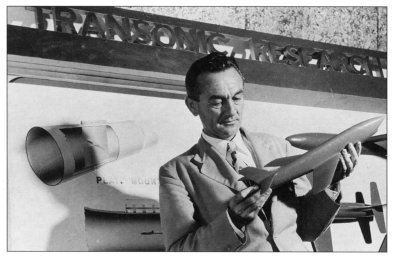 |
| John Stack, Langley Research Center scientist, was Presented the Collier Trophy in 1947, awarded for his conception of transonic research airplanes. His research contributed to the X-1 breaking the sound barrier on October 14, 1947. (NASA Photo No. LMAL 48991). |
1,116.2 feet per second. Measured values gave weighted means of 1,116.8 to 1,116.16 feet per second. Dryden noted that the specific heats were "not necessarily the same for all conditions" and suggested that the Committee select 1,117 feet per second as a round figure for a standard value of the speed of sound for sea level conditions for aeronautical usage. The outcome of this discussion appeared in the meeting minutes: "After further discussion it was agreed that the recommendation of a standard value for the speed of sound would be left for Dr. Dryden and Mr. Stack to work out jointly." Today, the accepted standard speed of sound depends on which "standard atmosphere" table you look at, ranging from a value of 1,116.4 feet per second in the 1959 ARDC Model atmosphere to 1,116.9 feet per second in the 1954 ICAO Model atmosphere. However, for engineering purposes this is splitting hairs, and Dryden's suggestion of a round value of 1,117 feet per second is still used today for many engineering calculations. Here is a little-known example of how the NACA played a role in the fundamentals of high-speed compressible aerodynamics even to the mundane extent of providing to industry a "standard" value of the speed of sound.
On October 14,1947, as the Bell X-1 nudged closer to Mach one, a region of the aerodynamic flow over the wing became locally supersonic. This is because the airflow increases its velocity while moving over the top of the wing, and hence there is always a region of the flow over the wing where the local velocity is larger than the velocity of the airplane itself. As the X-1 accelerated through Mach 0.87, a pocket of locally supersonic flow formed over the top of the wing. This supersonic pocket was terminated on the downstream end by a shockwave oriented almost perpendicular to the flow called a normal
64 RESEARCH IN SUPERSONIC FLIGHT AND THE BREAKING OF THE SOUND BARRIER
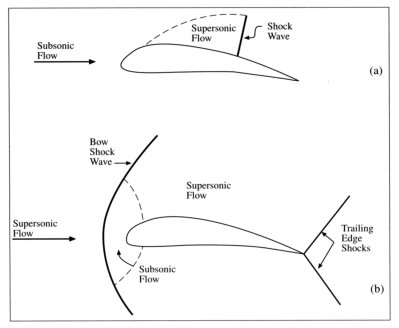 |
| Schematic of transonic flow over an airfoil. (a) Freestream flow slightIy below the speed of sound, typically a subsonic freestream Mach number from about 0.8 to 0.999. (b) Freestream flow Slightly above the speed of sound typically a supersonic freestream Mach number from 1.0 to about 1.2. |
shock (as shown above). This shock formation was the culprit which made flight through Mach one such a harrowing concern at that time. Finally, when the X-1 accelerated through Mach one to supersonic speeds, another shock wave formed a short distance in front of the nose; this shock, called the bow shock, was curved and more oblique to the flow (As shown above). Shock waves are extremely thin regions much thinner than the thickness of this page across which dramatic and almost discontinuous increases in pressure and temperature occur. Shock waves are a fact of life in the aerodynamic flow over transonic and supersonic airplanes.
Knowledge of shock waves is not unique to the twentieth century; their existence was recognized in the early nineteenth century. The German mathematician G. F. Bernhard Riemann first attempted to calculate shock properties in 1858, but he neglected an essential physical feature and hence obtained incorrect results.5 Twelve years later, William John Rankine, a noted engineering professor at the University of Glasgow, correctly derived the
5. A shock wave is, in thermodynamic language, an irreversible process, caused by viscosity and thermal conduction effects inside the shock wave. A measure of the amount of irreversibility is a thermodynamic variable called entropy, which from the Second Law of Thermodynamics always increases in any process involving such irreversibilities. The entropy of a gas always increases as it passes through a shock wave. Unfortunately, Riemann made the incorrect assumption that the entropy remained constant across a shock.
FROM ENGINEERING SCIENCE TO BIG SCIENCE 65
proper equations for the flow across a normal shock wave. Not cognizant of Rankine's work, the French ballistician Pierre Hugoniot rediscovered the normal shock wave equations in 1887. To the present day, the governing equations for flow across a shock wave are called the Rankine-Hugoniot equations, in honor of these two men.6 This work was expanded to include oblique shock waves by the famous German aerodynamicist, Ludwig Prandtl and his student Theodor Meyer at Göttingen University in 1908.7 Hence, only five years after the first flight by the Wright brothers, the necessary theory for the calculation of shock wave properties in a supersonic flow was in hand, albeit considered a purely academic subject at that time.
The nineteenth century was also a time of experimental work on supersonic
flow. Perhaps the most important event was the proof that shock waves were
not just a figment of the imagination they really existed in nature. This
proof was given by the physicistphysician-philosopher Ernst Mach in 1887.
Mach, while a professor of physics at the University of Prague, took the
first photographs of shock waves on a body moving at supersonic speeds.
Shock waves are normally invisible to the naked eye. But Mach devised a
special optical arrangement (called a shadowgraph) by which he could see
and photograph shock waves. In 1887, he presented a paper to the Academy
of Sciences in Vienna where he showed a photograph of a bullet moving at
supersonic speeds. Using his shadowgraph system, the bow shock and trailing
edge shock were made visible (as shown below). This historic photograph
allowed scientists, for the first time in history, to actually see a shock
wave. The experimental study of shock waves was off and running.
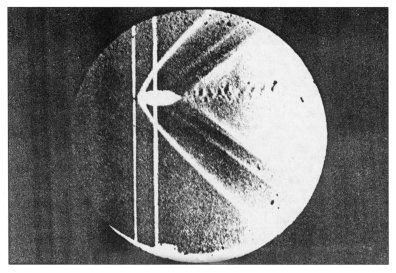 |
| Photograph of a bullet in supersonic flight, published by Ernst Mach in 1887. |
6. John D. Anderson, Jr., Modern Compressible Flow: With Historical Perspective, (New York, NY. McGraw Hill, 1990), pp. 92-95.
66 RESEARCH IN SUPERSONIC FLIGHT AND THE BREAKING OF THE SOUND BARRIER
This prehistory of supersonic flight, both theoretical and experimental, was carried out by basic researchers who were interested in the subject on an academic basis only. The true practical value of this work did not come to fruition until the advent of supersonic flight in the 1940s. However, this is an excellent example of the value of basic research on problems that appear only purely academic at the time. In the 1940s, when basic supersonic flow theory and fundamental understanding of shock waves was suddenly needed due to the advent of highspeed airplanes and rockets, it was there quietly residing and sleeping in a few dusty books and archive journal articles in the library.
In light of our earlier discussion of engineering science, was this early work on shock waves engineering science? Emphatically no! The researchers involved in this work were after scientific knowledge, and just that. There was no force behind these researchers driving them to design any related engineering artifacts at the time.8
Compressibility Problems: The First Inklings
(1918-1923)
Airplane aerodynamics, from the time of the Wright Flyer to the beginning of World War II, assumed that changes in air density were negligible as the air flowed over the airplane. This assumption, called incompressible flow, was reasonable for the 350 mph or slower flight speeds of airplanes during that era. Theoretically, it was a tremendous advantage to assume constant density, and physically the low-speed aerodynamic flows usually exhibited smooth variations with no sudden changes or surprises. All this changed when flight speeds began to sneak up close to the speed of sound. Aerodynamic theory had to account for changes in the air density in the flow field around the airplane, and physically the flow field sometimes acted erratically, and frequently surprised and greatly challenged aerodynamicists. Aerodynanticists in the 1930s simply threw these phenomena into one pot and called them generically "compressibility problems."
Ironically, the first inklings of compressibility problems occurred during the age of the strut-and-wire biplanes, with flight velocities about as far away from the speed of sound as you can get. It had to do with an airplane part, namely the propeller. Although typical flight speeds of World War I airplanes were less than 125 miles per hour, the tip speeds of propellers, because of their combined rotational and translational motion through the air, were quite large, sometimes exceeding the speed of sound. This fact was appreciated by aeronautical engineers at the time. This drove the British Advisory Committee for Aeronautics to show some interest in compressible flow theory. In 1918 and 1919, G. H. Bryan, working for the Committee at the Royal Aeronautical Establishment, carried out a theoretical analysis of subsonic and supersonic flows over a circular cylinder (a simple geometric shape chosen for convenience). He was able to show that in a subsonic flow the effect of compressibility was to displace adjacent streamlines farther apart. His analysis was cumbersome and complex a harbinger of things to come and provided little data of value. But it was evidence of the concern felt by the British over the effects of compressibility on propeller performance.9
At the same time, Frank Caldwell and Elisha Fales of the propeller branch of the Army Air Service Engineering Division at McCook Field in Dayton, Ohio, took a purely experimental
8. Report for the Year 1909-10, Advisory Committee for Aeronautics, England, p. 5.
9. G.H. Bryan, "The Effect of Compressibility on Streamline Motions," R & M No. 555, Technical Report of the Advisory Committee for Aeronautics, Vol. I, Dec. 1918; G .H. Bryan, "The Effect of Compressibility on Streamline Motions, Part II," R & M No. 640, Advisory Committee for Aeronautics, April 1919.
FROM ENGINEERING SCIENCE TO BIG SCIENCE 67
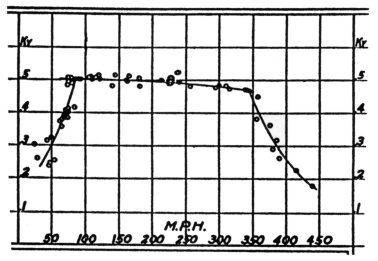 |
| The first data to show the adverse compressibility effects of high-speed flow over an airfoil. Caldwell and Fales, NACA TR 83, 1920. This is a plot of lift coefficient, Ky, versus velocity in miles per hour: The definition used for Ky at that time differed from the modern definition of lift coefficient (usually denoted by CL today) by a factor of two, i.e., CL = 2 Ky. The large drop in Ky seen at the right of the graph is the adverse effect of compressibility. (The ramp in Ky seen at the left of the graph was not explained by Caldwell and Fales; it is the present author's educated guess that the ramp was a low Reynolds number effect, because of the small size of the airfoil models used, namely a one inch chord.) |
approach to the problem. (This was the beginning of a blurred dichotomy between British and American research on compressibility effects. Over the next two decades, the major experimental contributions to understanding compressibility effects were to be made in the United States, principally by the NACA, and the major theoretical contributions were to be made in England.) In 1918, Caldwell and Fales designed and built the first high-speed wind tunnel in the United States purely to investigate the problems associated with propellers. The tunnel velocity range was from 25 to a stunning 465 miles per hour. It had a length of almost nineteen feet, and the test section was fourteen inches in diameter. This was a big and powerful machine for its day. Six different airfoils, with thickness ratios (ratio of maximum thickness to the chord length) from 0.08 to 0.2, were tested. At the higher speeds, the results showed "a decreased lift coefficient and an increased drag coefficient, so that the lift-drag ratio is enormously decreased." Moreover, the airspeed at which these dramatic departures took place was noted as the "critical speed."10 Because of its historical significance, some of their data is shown above, reproduced directly from NACA TR 83. Here, the lift coefficient for the airfoil at eight-degree
10. The critical Mach number is precisely defined as that freestream Mach number at which sonic flow is first encountered on the surface of a body. The large drag rise due to compressibility effects normally occurs at a freestream Mach number slightly above the critical Mach number; this is called the drag-divergence Mach number. In reality, Caldwell and Fales had reached and exceeded the drag-divergence Mach number in their experiments. But their introduction of the word "critical" in conjunction with this speed was eventually the inspiration for its rise in later coining the term "critical Mach number."
68 RESEARCH IN SUPERSONIC FLIGHT AND THE BREAKING OF THE SOUND BARRIER
angles of attack is plotted versus airstream velocity. Note the dramatic drop in lift coefficient at the "critical speed" of 350 miles per hour the compressibility effect. This plot, and ones like it for other angles of attack that were published in NACA TR 83, are the first published data in the history of aerodynamics to show the adverse effects of compressibility. Although Caldwell and Fales made an error in the reduction of their data (an understandable error associated with the inexperience of dealing with compressible flow conditions at the early date of 1919) which caused their reported lift and drag coefficients to be about ten percent too low at the higher speeds, this did not compromise the dramatic and important discovery of the large increase in drag and decrease in lift when the airfoil sections were tested above the "critical speed." Moreover, they were the first to show that the "critical speed" for thin airfoils was higher than that for thick airfoils, and hence by making the airfoil section thinner, the adverse compressibility effects can be delayed to higher Mach numbers. This was an important finding, and one which would have a lasting impact on high-speed vehicle design.11
It is noteworthy that the fledgling NACA was the government agency which published the results of Caldwell and Fales. 12 The NACA was carrying out its duty as stated in Public Law 271, which created the Committee in 1915, namely "to supervise and direct the scientific study of the problems of flight, with a view to their practical solution, and to determine the problems which should be experimentally attacked, and to discuss their solution and their application to practical questions." Publishing the Caldwell and Fales work is in the latter category the NACA was already earmarking compressibility effects as a problem "which should be experimentally attacked."
In the chronology of events, the British were next to examine the effects of compressibility on propellers. In 1923, G. P. Douglas and R. McK. Wood, two aerodynamicists at the Royal Aeronautical Establishment, tested model propellers at high rotational speeds in the seven-foot low-speed wind tunnel (100 miles per hour airstream) at the National Physical Laboratory in London.13 They also carried out flight tests on a DeHaviland D.H. 9A biplane. Their data were the global measurements of the thrust and torque generated by the whole propeller, so the details of the compressibility effects affecting the airfoil sections at the tip of the propeller were somewhat obscured. However, one of their conclusions anticipated the adverse effects of compressibility, namely that "higher tip speeds than at present used will probably involve a serious loss of efficiency."
11. This author, upon Studying Caldwell and Fales detailed data reduction, has found that, although they recognized that the density of the airflow changed inside the wind tunnel at the higher speeds, their accounting for this in calculating their lift and drag coefficients from their measured lift and drag forces was done incorrectly. They thought they had worked their data reduction so that "density does not enter into the calculation." Rather, they expressed their lift and drag coefficients in terms of the impact pressure the difference between total and static pressure. This is why they said that "density does not enter into the calculation." But they incorrectly and rather naively used the incompressible Bernoulli equation to replace the velocity-squared term in the definition of lift coefficient with the impact pressure. This resulted in about a ten percent error in the values of their reported lift and drag coefficients at high speeds. For more details, see John D. Anderson, Jr., The History of Aerodynamics, and its Impact on Flying Machines (New York, NY: Cambridge University Press, 1997).
12. F. W. Caldwell, and E. Fates, "Wind Tunnel Studies in Aerodynamic Phenomera at High Speed." NACA TR 83,1920.
13. G.P. Douglas and R. McK. Wood, "The Effects of Tip Speed on Airscrew Performance. Air Experimental Investigation of the Performance of an Airscrew Over a Range of Speeds of Revolution from 'Model' Speeds tip to Tip Speeds in Excess of the Velocity of Sound in Air," R & M No. 884, Advisory Committee for Aeronautics, 1923.
FROM ENGINEERING SCIENCE TO BIG SCIENCE 69
The Compressibility BurbleNACA's Seminal
Research, 1924-1929
Meanwhile, the NACA was forging ahead. During the 1920s, the Committee sponsored a series of fundamental experiments in high-speed aerodynamics at the Bureau of Standards with Lyman J. Briggs and Dr. Hugh L. Dryden. Hugh Dryden was a fresh, young Ph.D. graduate from Johns Hopkins University in physics; he had received his Ph.D. in 1919 at the age of twenty. (Dryden much later was to become the Director of Research for the NACA front 1947 to 1958.) This work progressed in three stages, each one documented in a separate NACA Technical Report, and covered the period from 1924 to 1929. As before, the primary motivation for this research was to understand the compressibility effects at the tips of propellers.
The first stage simply confirmed the trends already observed by Caldwell
and Fales four years earlier. Briggs and Dryden, with the help of Lt. Col.
G. F. Hull of the Army Ordnance Department, jury-rigged a highspeed wind
tunnel by connecting a vertical standpipe thirty inches in diameter and
thirty feet high to a large centrifugal compressor at the Lynn Works of
the General Electric Company in Massachusetts. At the other end of the
pipe was a cylindrical orifice that served as a nozzle 12.24 inches in
diameter. With this device "air speeds approaching the speed of sound were
obtained."14 Unlike Caldwell and Fales,
Briggs and Dryden used the proper equations for compressible flow to calculate
the air velocity Although not yet in the standard textbooks, these equations
were known by Dryden as a result of his Ph.D. studies in physics. (The
first engineering textbook in English to focus on compressible flow was
not published until 1947.)15 Rectangular
planform models, with a span of 17.2 inches and a chord length of three
inches, were placed in the high-speed airstream, and lift, drag and center-of-pressure
were measured. The results supported the earlier trends observed by Caldwell
and Fales. In particular, Briggs found:16
In 1924, the culmination of this work, as well as that which went
before, was the waving of a red flag compressibility effects were nasty
and they markedly degraded airfoil performance. But nobody had any fundamental
understanding of the physical features of the flow field which were causing
these adverse effects. This was not to come for another decade.
Briggs and Dryden made an important step towards this fundamental understanding in the second stage of their work. Because the Lynn Works compressor was no longer available to them, Briggs and Dryden moved their experimental activity to the Army's Edgewood Arsenal, where they constructed another high-speed wind tunnel, this one much smaller, with an airstream only two inches in diameter. However, by careful design of the small airfoil models, two pressure taps could be placed in each model. Seven identical
14. L. J. Briggs; G.F. Hull; and Hugh L Dryden, "Aerodynamic Characteristics of Airfoils at High Speeds," NACA TR 207, 1924.
15. Hans W. Liepmann, and Allen E. Puckett, Introduction to Aerodynamics of a Compressible Fluid (New York, NY. John Wiley and Sons, 1947).
16. L. J. Briggs and Hugh L. Dryden, "Pressure Distribution Over Airfoils at High Speeds," NACA TR 255, 1926.
70 RESEARCH IN SUPERSONIC FLIGHT AND THE BREAKING OF THE SOUND BARRIER
models were used, each one with different locations of the pressure taps. A total of thirteen pressure tap locations, seven on the upper surface and six on the lower surface, were employed (for the reader who is counting, the seventh model had only one tap).
With this technique, Briggs and Dryden measured the pressure distributions over the airfoil at Mach numbers from 0.5 to 1.08. The results were dramatic! Beyond the "critical speed," the pressure distributions over the top of the airfoil exhibited a sudden pressure ,jump at about one-third to one-half the distance from the leading edge, followed by a rather long plateau towards the trailing edge. Such a pressure plateau was familiar it was very similar to that which exists over the top surface of an airfoil in low-speed flow when the airfoil stalls at high angle of attack. And it was well known that airfoil stall was caused by the separation of the flow off the top surface of the airfoil. Briggs and Dryden put two-and-two together, and concluded that the adverse effects of compressibility were caused by flow separation over the top surface, even though the airfoil was at low (even zero) angle of attack. To substantiate this, they conducted oil flow tests, wherein a visible, pigmented oil was painted on the model surface, and the model was placed in the high-speed airstream. During the tests, the tell-tale flow separation line formed on the oil pattern. Clearly, beyond the "critical speed," flow separation was occurring on the top surface of the airfoil. The next question was: Why? What was causing the flow to separate? The answer to this question still lay eight years in the future.
Was this work of Briggs and Dryden engineering science? Emphatically yes! Their experiments were designed to obtain basic scientific information about the physics of the high-speed flow over an airfoil, but always for the purpose of learning how to design better airfoil shapes for high-speed flight.
The third stage of the work by Briggs and Dryden was utilitarian, and was in keeping with the stated duty of the NACA to work on the problems of flight "with a view to their practical solution." Towards the end of the 1920s, they carried out a large number of detailed measurements of the aerodynamic properties for 24 different airfoils at Mach numbers from 0.5 to 1.08. The airfoils chosen were those conventionally used by the Army and the Navy for propellers, consisting of the standard family of British-designed RAF airfoils, and the American-designed Clark Y family. These data provided the first definitive measurements on standard series of airfoils showing compressibility effects. 17
It should be noted that theoretical solutions of high-speed compressibility effects in a subsonic flow were virtually non-existent during the 1920s. The only major contribution was that by the famous British aerodynamicist Herman Glauert, who rigorously derived a correction to be applied to the low-speed, incompressible lift coefficient in order to correct it for compressibility effects.18 This was the first of a series of theoretical rules labeled "compressibility corrections." Because it was known that Ludwig Prandtl in Germany had also derived the same rule a few years earlier, but had not published it, Glauert's result has come down through the decades as the Prandtl-Glauert Rule. However, such compressibility corrections are applicable to the variation of lift coefficient with speed below the "critical speed," and hence have no way of predicting the lift coefficient in the "compressibility burble."
Throughout this, the primary motivation for all the above work on compressibility effects was for application to airplane propellers. But the focus was about to change, and change dramatically.
17. L. J. Briggs and Hugh L. Dryden, "Aerodynamic Characteristics of Twenty-Four Airfoils at High Speeds," NACA TR 319,1929.
18. H. Glauert, "The Effect of Compressibility on the Lift of an Airfoil, "Journal of the Royal Society 118 (1927): 113. Also published as R & M No. 1135, Advisory Committee for Aeronautics, September 1927.
FROM ENGINEERING SCIENCE TO BIG SCIENCE 71
John Stack and the NACA Compressible Flow
ResearchA Breakthrough
In July 1928, a young New Englander, born and raised in Lowell, Massachusetts, began his career with the NACA Langley Memorial Aeronautical Laboratory. Having just graduated from the Massachusetts Institute of Technology with a B.S. degree in aeronautical engineering, John Stack was assigned to the Variable Density Tunnel, the premier wind tunnel in the world at that time. Stack was absolutely dedicated to aeronautical engineering. While in high school, he earned money so that he could take a few hours of flight instruction in a Canuck biplane. He helped out with the maintenance of a Boeing biplane owned by one of his part-time employers. Before he went to college, he had made up his mind to be an aeronautical engineer. However, his father, a carpenter who was also very successful in real estate, wanted his son to study architecture at MIT. Instead, when Stack entered MIT, he enrolled in aeronautical engineering, keeping it a secret from his father for the first year, but with the understanding approval of his mother. Much later, Stack commented: "Then when Dad heard about it, it was too late to protest."19
When John Stack first walked into the Langley laboratory that July of 1928, a year's worth of design work had already been done on Langley's first high-speed tunnel, and the facility was already operational with an open throat test section.20 Success had been achieved by the work of Briggs and Dryden, and the growing importance of high-speed research was perceived by some visionaries. Because of this perception, Joseph S. Ames, President of Johns Hopkins University and the new Chairman of the NACA, in 1927 gave priority to high-speed wind tunnels and research.21 Eastman Jacobs, who had joined the NACA in 1925 after receiving his B.S. degree in mechanical engineering from the University of California, Berkeley, was the chief designer of the open-throat eleven-inch High Speed Tunnel. (Jacobs would later earn air international reputation for his work on the famous NACA airfoil sections in the 1930s, and for his conception of, and pioneering research on, the NACA laminar flow airfoils just before the beginning of World War II.) An innovative aspect of the eleven-inch High Speed Tunnel was that it was driven from the twenty atmosphere pressure tank of the Langley Variable Density Tunnel. For a change in models in the Variable Density Tunnel, the twenty atmosphere tank which encased the entire tunnel was blown down to one atmosphere; this represented a wasted energy source which the Langley engineers ingeniously realized could be tapped for the eleven-inch High-Speed Tunnel. The 5,200 cubic foot capacity of the high pressure tank allowed about one minute of operation for the tunnel. John Stack was given the responsibility for improving the High-Speed Tunnel by designing a closed throat. This improved facility, shown on the next page, was operational by 1932. It was his participation in the design and development of the eleven-inch High-Speed Tunnel that launched John Stack on his life-long career in high-speed aerodynamics.
While Stack was working on the High-Speed Tunnel, an event occurred in England which made a great impression on him, and which would rapidly refocus the NACA high-speed research program. On Sunday, September 13, 1931, a beautiful, highly streamlined Supermarine S.6B flashed through the clear early afternoon sky at Calshot, near Portsmouth along the southern English coast. Flown by Flt. Lt. John N. Boothman, this exquisite racing
19. Lou Davis, "No Time for Soft Talk," National Aeronautics, January 1963, pp. 9-12. 'This is an interesting biographical article written about Stack at the time of his receiving the 1962 Wright Memorial Trophy Award from the National Aeronautic Association.
20. James R. Hansen, Engineer in Charge: A History of the Langley Aeronautical Laboratory, 1917-1958 (Washington, DC: NASA SP-4305,1987), p. 446.
21. Donald D. Corliss, Wind Tunnels of NASA (Washington, DC: NASA SP-440,1981).
72 RESEARCH IN SUPERSONIC FLIGHT AND THE BREAKING OF THE SOUND BARRIER
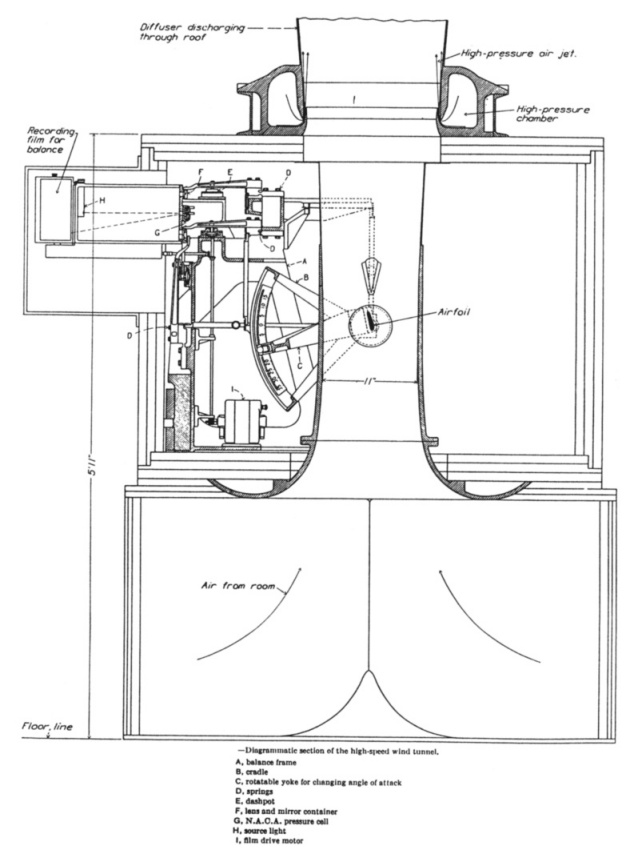 |
| The 11-inch High-Speed Tunnel at NACA Langley; closed-throat modification in 1932. |
FROM ENGINEERING SCIENCE TO BIG SCIENCE 73
airplane averaged a speed of 340.1 mph around a long, seven-lap course, winning the coveted Schneider Trophy permanently for Britain. Later that month, on September 29, Flt. Lt. George H. Stainforth set the world's speed record of 401.5 mph in the same S.6B. Looking at this figure, it does not take an aerodynamic expert to appreciate that by 1931 the concept of streamlining in order to reduce drag had taken root. The Supermarine S.6B simply looked like it could fly at 400 miles per hour-at Mach 0.53, over half the speed of sound. Suddenly, the aeronautical engineer's concern over compressibility effects on propeller tips, an important but tolerable situation, became an absolutely major concern over compressibility effects on the airplane itself, a problem of showstopper proportions.
Such concern was beginning to dawn on the aircraft industry itself In
1936, Lockheed's Kelly Johnson began early design studies for the P-38,
which was the first airplane to encounter major, and sometimes fatal, compressibility
effects. By the mid-1930s, the aircraft industry was wading into uncharted
water, and the NACA's high-speed research program became absolutely vital
to the future progress of high-speed airplane design.
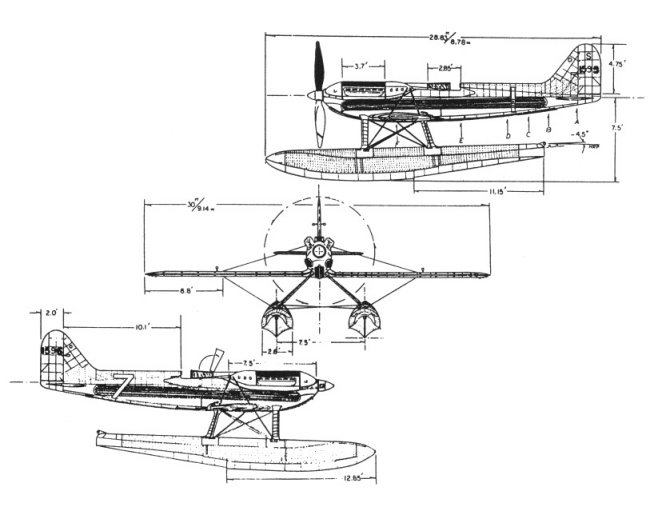 |
| The Supermarine S.6B, the airplane used by the British to win the Schneider Trophy, 1931. |
74 RESEARCH IN SUPERSONIC FLIGHT AND THE BREAKING OF THE SOUND BARRIER
Stack became acutely aware of this new compressibility challenge. In
1933, he published in NACA TR 463 the first data to come from the newly
modified, closed-throat High-Speed Tunnel. Although the airfoils were propeller
sections, Stack wrote in the introduction, obviously referring to the Schneider
Trophy racer:
A knowledge of the compressibility phenomenon is essential, however because the tips speeds of propellers now in use are commonly in the neighborhood of the velocity of sound. Further, the speeds that have been attained by racing airplanes are as high as half the velocity of sound. Even at ordinary airplane speeds the effects of compressibility should not be disregarded if accurate measurements are desired . 22
For the most part, Stack's data in 1933 served to confirm the trends
observed earlier. For example, Stack's measurements of the variation of
drag coefficient with Mach number for a ten percent thick Clark Y airfoil
are shown below; the large drag rise at high
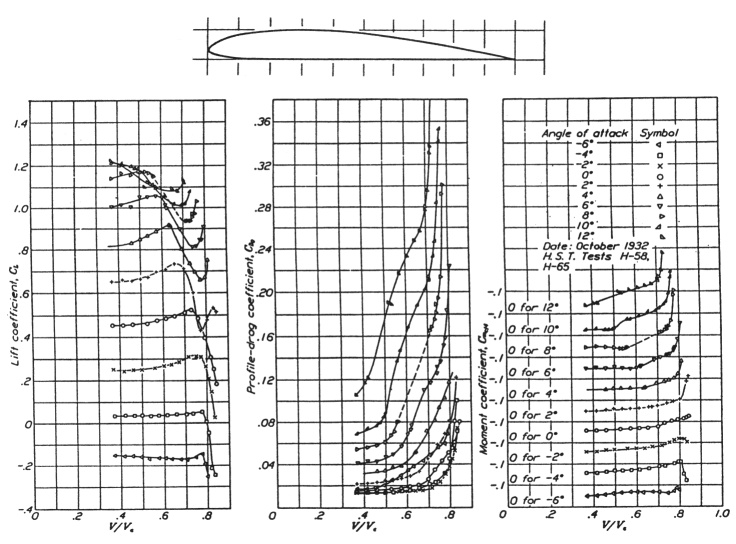 |
| The first compressibility data published by John Stack. From NACA TR 463, 1933. The three graphs are, from left to right, the variations of lift coefficient, drag coefficient, and moment coefficient, respectively, versus the ratio of the freestream velocity to the speed of sound (the Mach number). The test model was a 3C1D airfoil, shown at the top of the figure. The adverse effects of compressibility are seen in the precipitous decease in lift coefficient and dramatic increase in drag coefficient as the Mach number is increased. |
22. John Stack, "The N.A.C.A. High-Speed Wind Tunnel and Tests of Six Propeller Sections," NACA TR 463, 1933. At about the time of World War I, aerodynamicists were familiar with the fact that an airfoil stalled at high angle of attack because the flow, separated from the top surface. The resulting drastic loss of lift was given the term "lift burble." Hence, after Briggs and Dryden had shown that the drastic loss of lift at high speeds, beyond the "critical speed," was also due to flow separation, it was natural to call this effect the "coumpressibility burble." This terminology, coined by the NASA in 1933, pervaded the high-speed aerodynamic literature throughout the 1930s.
FROM ENGINEERING SCIENCE TO BIG SCIENCE 75
speeds is clearly evident. He also confirmed that the onset of the adverse compressibility effects occur at lower Mach numbers as either or both the airfoil thickness and angle of attack increase. One of his conclusions reflected on the theoretical Prandtl-Glauert compressibility correction mentioned earlier. From his measurements, Stack concluded: "These results indicate that the limited theory available may be applied with sufficient accuracy for most practical purposes only for speeds below the compressibility burble." This conclusion presaged almost forty years of a theoretical void. The aerodynamic equations applicable to the transonic flight regime, Mach numbers between about 0.8 and 1.2 are non-linear partial differential equations that defied solution until the 1970s. And even then the solution was by brute force-numerical solutions using the power of the newly developed discipline of computational fluid dynamics carried out on high-speed digital supercomputers.
By the way, the term "compressibility burble" was coined by Stack in the same NACA Technical Report. He wrote:
The lift coefficients increase as the speed is increased, slowly as the speed is increased over the lower portion of the range, then more rapidly as speeds above half the velocity of sound are exceeded, and finally at higher speeds, depending on the airfoil section and the angle of attack, the flow breaks down as shown by a drop in the lift coefficient.This breakdown of the flow, hereinafter called the compressibility burble, occurs at lower speeds as the lift is increased by changing the angle of attack of the model.23Driven by the conviction and foresight of John Stack, the NACA now waved the red flag of compressibility problems to the whole world of aeronautical engineering. In January 1934, the first significant professional aeronautical society in the United States, the Institute of Aeronautical Sciences, published the first issue of its soon-to-be recognized premier journal, the Journal of the Aeronautical Sciences. It contained an article by Stack entitled "Effects of Compressibility on High Speed Flight."24 In the first paragraph, Stack makes clear the theme that would be played out by the NACA for the next several decades:
The effects of compressibility have commonly been neglected because until the relatively recent development of the last Schneider trophy aircraft the speeds have been low as compared with the velocity of sound and the consequent local pressures over the surfaces of high-speed airplanes have differed but slightly from atmospheric pressure. At the present time, however, the speeds associated with the fastest airplanes approach 60 percent of the velocity of sound, and the induced velocities over their exposed surfaces lead to local pressures that differ appreciably from the pressure of the atmosphere. When this condition exists, air can no longer be regarded as an incompressible medium. The effects of compressibility on the aerodynamic characteristics of airfoils have been under investigation by the N.A.C.A. in the highspeed wind tunnel, and it is the purpose of this paper to examine the possibility of further increases in speeds in the light of this relatively recent research.By this time, it was clear that the NACA was the leading research institution in the world in the area of compressibility effects. Through its influence and sponsorship of the fledgling experiments in the 1920s by Caldwell and Fales at McCook Field, and by Briggs
24. John Stack, "Effects of Compressibility on High Speed Flight," Journal of the Aeronautical Sciences 1(January 1934): 40-43.
76 RESEARCH IN SUPERSONIC FLIGHT AND THE BREAKING OF THE SOUND BARRIER
and Dryden at the Bureau of Standards, and now by its own carefully conducted experiments at Langley, the NACA had been able to identify the first two aspect's of the basic nature of compressibility effects, namely that (1) above a certain "critical speed," the lift decreased dramatically and the drag skyrocketed almost beyond comprehension, and (2) this behavior was caused by sudden and precipitous flow separation over the top surface of the wing or airfoil. There remained one question, the most important of all Why?
John Stack and the NACA were responsible for the answer to this question a breakthrough that occurred in 1934. By this time, Stack had a new instrument with which to work a schlieren photographic system, an optical arrangement that made density gradients in the flow visible. One of nature's mechanisms for producing very strong density gradients is a shock wave; hence a shock wave ought to be visible in a schlieren photograph. Stack's boss, Eastman Jacobs, was familiar with such optical systems through his hobby of astronomy; it was in keeping with Jacob's innovative mind to suggest to Stack that the use of a schlieren system might make visible some of the unknown features of the compressible flow field over an airfoil, and might shed some light on the nature of the compressibility burble. It did just that, and more!
With the 11-inch tunnel running above the "critical speed" for an NACA
0012 symmetric airfoil mounted in the test section, and with the aid of
the schlieren system, Stack and Jacobs observed for the first time in the
history of aerodynamics a shock wave in the flow over the top surface of
the airfoil. The shockwave was like that sketched in the figure below.
It became immediately clear to these two experimentalists that the separated
flow over the top surface of the airfoil, and the resulting compressibility
burble with all its adverse consequences, was caused by the presence of
a shock wave. The nature of this flow is sketched below, and it clearly
shows that the shock wave interacts with the thin, friction-dominated boundary
layer adjacent to the surface of the airfoil. This causes the boundary
layer to separate in the region where the shock impinges on the surface.
A massive region of separated flow trails downstream, greatly increasing
the drag and decreasing the lift. One of the pioneering schlieren pictures
of the flow over the NACA 0012 airfoil taken by Stack in 1934 is shown
on the page 73.25 The quality is poor
by present-day standards, but it is certainly sufficient for identifying
the phenomena. This is a historic photograph in the annals of the history
of aerodynamics one which led to the final understanding of the physical
nature of the compressibility burble. This was a breakthrough of enormous
intellectual and practical importance. And it was totally due to the work
of two innovative and highly intelligent aerodynamicists at the NACA Langley
Laboratory, John Stack and Eastman Jacobs, operating under the umbrella
of an inspired creative atmosphere associated with the NACA in general,
 |
| Schematic of shock-induced separated flow the source of the compressibility burble. |
25. Found by the author in the John Stack Files, NASA Langley Historical Archives.
FROM ENGINEERING SCIENCE TO BIG SCIENCE 77
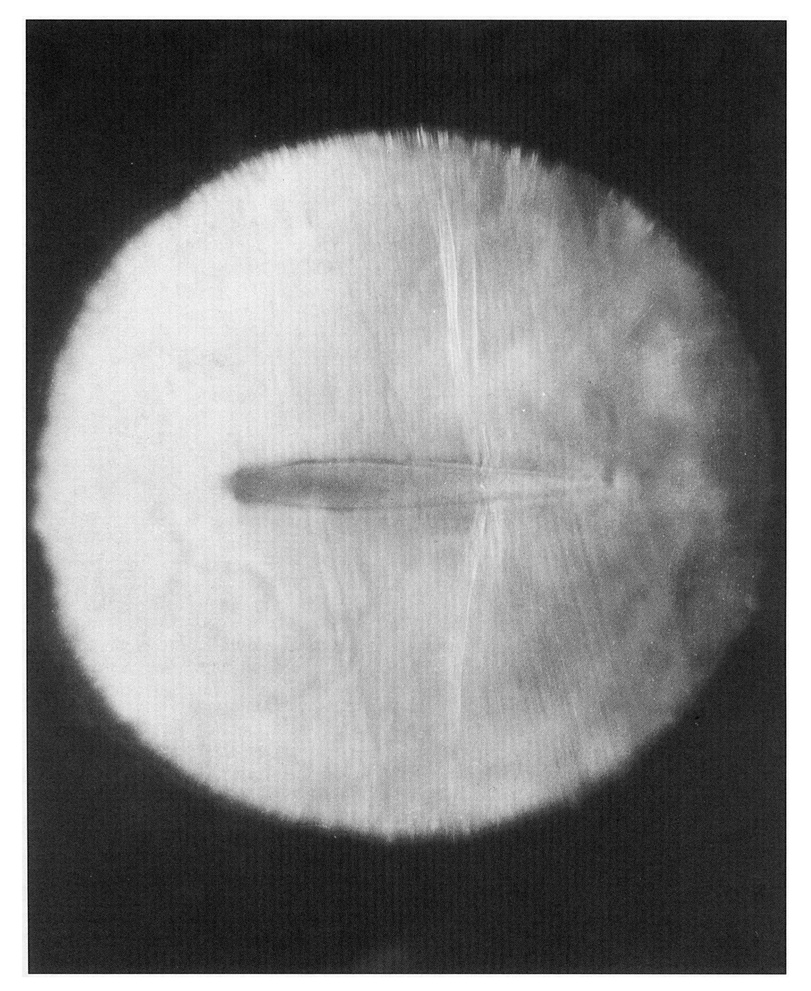 |
| An early schlieren photograph of the shock pattern on an NACA 0012 airfoil in a freestream above the "critical speed". From the first group of schlieren Photographs of the compressibility burble taken by John Stack, 1934. In this photograph the nature of the flow Pattern causing the compressibility burble was seen for the first time. From the John Stack papers in the NASA Langley Archives. Courtesy of Richard Layman, Archivist. |
78 RESEARCH IN SUPERSONIC FLIGHT AND THE BREAKING OF THE SOUND BARRIER
and the foresight of Joseph Ames and George Lewis at NACA Headquarters in Washington who placed priority on the NACA high-speed research program at a time when most airplanes of the day were lumbering along at 200 mph or slower.
Was this work by Stack and Jacobs engineering science? Absolutely yes! It provided the fundamental physical understanding of the root source of compressibility problems. This understanding was mainly qualitative at the time, but it allowed designers of high-speed airfoils to make more intelligent decisions about proper airfoil shapes-it helped to make the uncharted waters more navigable.
As with many new discoveries in science and technology, there are always
those skeptical at first. One of those was Theodore Theodorsen, the best
theoretical aerodynamicist in the NACA at the time, with a worldwide reputation
for his pioneering papers on airfoil theory. John Becker, who joined the
NACA in 1936 and who went on to become one of the most respected high-speed
acrodynamicists at Langley, tells the following anecdote about Theodorsen's
reaction to the schlieren photographs taken by Stack and Jacobs. It is
repeated here because it reflects just how much a radical departure from
the expected norm the results were.
The first tests were made on a circular cylinder about 1/2 inch in diameter and the results were spectacular in spite of the poor quality of the optics. Shockwaves and attendant flow separations were seen for the first time starting at subsonic stream speeds of about 0.6 times the speed of sound. Visitors from all over the Laboratory, from Engineer-in-Charge H .J. E. Reid on down, came to view the phenomena. Langley's ranking theorist, Theodore Theodorsen, viewed the results skeptically, proclaiming that since the stream flow was subsonic, what appeared to be shockwaves was an 'optical illusion,' an error in judgement which he was never allowed to forget.26
An interesting confluence of events occurred in 1935 that allowed
the NACA in a timely fashion to inform the international research community
of this intellectual breakthrough in understanding compressibility effects
and the compressibility burble. One was the exisitence of the data itself
fresh, exciting, and revolutionary. The other was the scheduling of the
fifth Volta conference in Italy.27
Since 1931, the Royal Academy of Science in Rome had been conducting a
series of important conferences sponsored by the Alessandro Volta Foundation.
The first conference dealt with nuclear physics, and then rotated between
the sciences and the humanities on alternate years. The second Volta conference
had the title "Europe" and in 1933 the third conference was on the subject
of immunology.
This was followed by the subject "The Dramatic Theater" in 1934. During this period, the influence of Italian aeronautics was gaining momentum, led by General Arturo Crocco, an aeronautical engineer who had become interested in ramjet engines in 1931, and therefore was well aware of the potential impact of compressible flow theory and experiment on future aviation. This led to the choice of the topic of the fifth Volta conference "High Velocities in Aviation." Participation was by invitation only, and the select list included all the leading aerodynamicists at that time. Because of his reputation in the design and testing of the famous NACA four-digit airfoil series, and the fact that he was the Section Head of the NACA Variable Density Tunnel which had put the NACA on the international aerodynamic map in the 1920s, Eastman Jacobs received an invitation. He took the opportunity to present a paper on the new NACA compressibility research.
26. John V Becker, The High-Speed Frontier: Case Histories of Four NACA Programs, 1920-1950 (Washington, DC: NASA SP-445, 1980), p. 16.
27. Anderson, Modern Compressible Flow, pp. 282-84.
FROM ENGENEERING SCIENCE TO BIG SCIENCE 79
Hence, during the period between September 30 and October 6, 1935, the major figures in the development of high-speed aerodynamics of the 1930s (with the exception of John Stack) gathered inside an impressive Renaissance building in Rome that served as the city hall during the Holy Roman Empire, and discussed flight at high subsonic, supersonic, and even hypersonic speeds. The fifth Volta Conference was to become the springboard for new thought on the development of high-speed flight.
In the midst of all this discussion was Eastniann Jacobs representing the NACA. Jacobs' paper, entitled "Methods Employed in America for the Experimental Investigation of Aerodynamic Phenomena at High Speeds," was both tutorial and informative.28 He took the opportunity to derive and present the basic equations for compressible flow assuming no friction and no thermal conduction. Then he described the NACA High-Speed Tunnel, the schlieren system, and the airfoil experiments carried out in the tunnel. Then came the blockbuster. He showed, for the first time in a technical meeting, some of the schlieren pictures taken at Langley. One of these was the photograph shown on page 73. Conscious of the NACA:s penchant for perfection, especially in its publications, Jacobs apologized for the quality of the photographs, a very modest gesture considering their technical (and historical) importance: "Unfortunately the photographs were injured by the presence of bent celluloid windows forming the tunnel walls through which the light passed. The pictures nevertheless give fundamental information in regard to the nature of the flow associated with the compressibility burble."29 With this, the NACA high-speed research program was not only on the map, it was leading the pack.
By this time, Stack had a newer, larger facility the 24-inch High Speed Tunnel equipped with an improved schlieren system, The basic testing of compressibility effects on flows over airfoils continued in this facility. In 1938, Stack published the most definitive document yet on the nature of high-speed compressible flow over airfoils, including many detailed surface pressure measurements.30 With this, the NACA continued to be the undisputed leader in the study of the effects of compressibility and the consequences of the compressibility burble.
The atmosphere at the Langley Laboratory during the 1930s allowed engineering science to flourish, although the laboratory never explicitly adopted this as a priority. lt just happened when it needed to happen. The culture among its engineers was one, of inquiry and free exchange of information; thoughts were readily shared on an inter-personal basis. Moreover, Langley had engineers who were adept at building new facilities, especially new wind tunnels. It was natural that a high-speed wind tunnel was built at Langely providing a unique facility for Langley engineers to unlock the secrets of high-speed aerodynamics. And the fact that the NACA had money, even during the depression years, allowed such wind tunnels to be first-class facilities. All this, in combination with first-class engineers and scientists, made Langley the leading research institution in high-speed compressibility effects during the 1930s.
Jacobs' paper at the fifth Volta conference represented in some sense a celebration of the second phase of the NACA research on high-speed flight. The First phase was the embryonic wind tunnel compressibility work of the 1920s, clearly oriented towards applications to propellers.
28. Eastman Jacobs, "Methods Employed in America for the Experimental Investigation of Aerodynamic Phenomena at High Speeds," NACA Misc. Paper No. 42, March 1936. A copy of this paper. which is the printed version of Jacobs' presentation at the fifth Volta conference, is available in the Technical Documents Section, Mathematics, Engineering and Physical Sciences Library, University of Maryland, College Park.
30. John Stack, W.F. Lindsey, and Robert E. Littell, "The Compressibility Burble and the Effect of Compressibility on Pressures and Forces Acting on an Airfoil," NACA TR 646,1938.
80 RESEARCH IN SUPERSONIC FLIGHT AND THE BREAKING OFTHE SOUND BARRIER
The second phase was the refocusing of this high-speed wind tunnel research on the airplane itself, complemented by a new initiative the design and development of an actual research airplane.
The High-Speed Research Airplane: An NACA Idea
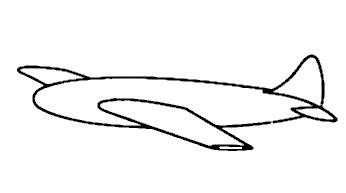 |
| Hypothetical high-speed airplane conceived by John Stack, 1933 |
31. Stack, "Effects of Compressibility on High Speed Flight," pp. 40-43.
32. Hansen, Engineer in Charge, p. 256.
FROM ENGINEERING SCIENCE TO BIG SCIENCE 81
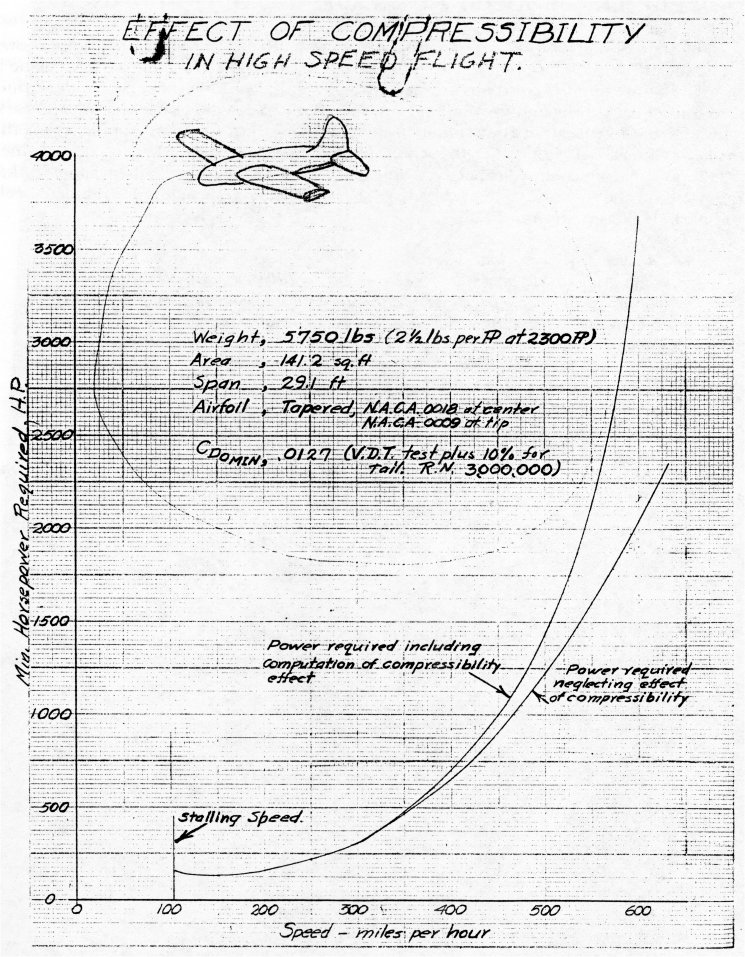 |
| Graph and sketch hand-drawn by John Stack, 1933. The effect of compressibility on the power required for a hypothetical airplane.This sketch was subsequently sent to the October 1933 Committee Meeting of the NACA in Washington. From the John Stack papers at the NASA Langley Archives. |
82 RESEARCH IN SUPERSONIC FLIGHT AND THE BREAKING OFTHE SOUND BARRIER
The High-Speed Research Airplane-For Real
The state of high-speed aerodynamics in 1939 can be illustrated by one
graph, shown schematically in the figure below. Here, the variation of
drag coefficient for an airplane is shown as a function of free stream
Mach number. On the subsonic side, below Mach one, wind tunnel data indicated
the familiar rapid increase in drag coefficient as Mach one is approached.
On the supersonic side, ballisticians had known for years, supported by
the results of linearized supersonic theory developed by Jakob Ackeret
in Germany since 1928, how the drag coefficient behaved above Mach one.33
Of course, all airplanes at that time were on the subsonic side of the
curve shown in the figure below. John Stack nicely summarized the situation
in 1938:
The development of the knowledge of compressible-flow phenomena, particularly as related to aeronautical applications, has been attended by considerable difficulty. The complicated nature of the phenomena has resulted in little theoretical progress, and, in general, recourse to experiment has been necessary. Until recently the most important experimental results have been obtained in connection with the science of ballistics, but this information has been of little value in aeronautical problems because the range of speeds for which most ballistic experiments have been made extends from the speed of sound upward; whereas the important region in aeronautics at the present time extends from the speed of sound downward. 34
In essence, the flight regime Just below and just beyond the speed
of sound was unknown a transonic gap, as shown schematically below.
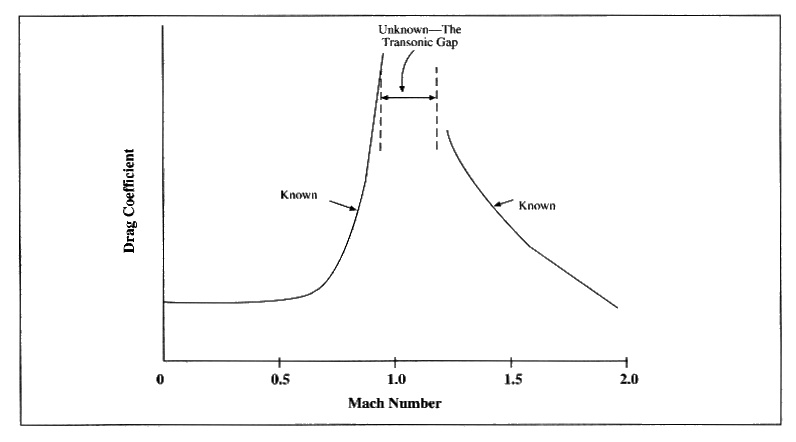 |
| Schematic of the subsonic and supersonic variations of drag coefficient for an airfoil, illustrating the position of the transonic regime for which virtually no information was available in the 1930s and 1940s. |
33. Anderson, Modern Compressible Flow, pp. 270-73.
34. Stack; Lindsey; and Littell, "Compressibility Burble and the Effect of Compressibility on Pressures and Forces Acting on an Airfoil."
FROM ENGINEERING SCIENCE TO BIG SCIENCE 83
The general aeronautics community was suddenly awakened to the realities
of the unknown flight regime in November 1941, when Lockheed test pilot
Ralph Virden could not pull the new, high-performance P-38 out of a high-speed
dive, and crashed. Virden was the first human fatality due to adverse compressibility
effects, and the P-38, shown below, was the first airplane to Suffer from
these effects. The P-38 exceeded its critical Mach number in an operational
dive, and penetrated well into the regime of the compressibility burble
at its terminal dive speed, as shown by the bar chart on page 80 .35
The problem encountered by Virden, and many other P-38 pilots at that time,
was that beyond a certain speed in a dive, the elevator controls suddenly
felt as if they were locked. And to make things worse, the tail suddenly
produced more lift, pulling the P-38 into an even
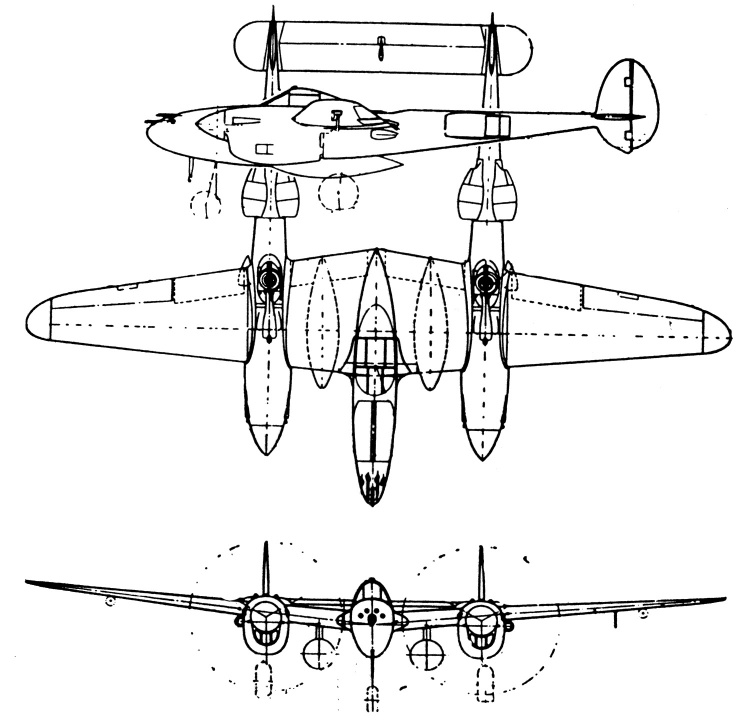 |
| Lockheed P-38, the first airplane to encounter severe compressibility problems. |
35. This chart is taken from the figure on page 78 of the article by R. L. Foss, "From Propellers to Jets in Fighter Aircraft Design," in Jay D. Pinson, ed., Diamond Jubilee of Powered Flight: The Evolution of Aircrafeet Design (New York, NY: American Institute of Aeronautics and Astronautics, 1978), pp. 51-64.
84 RESEARCH IN SUPERSONIC FLIGHT AND THE BREAKING OF THE SOUND BARRIER
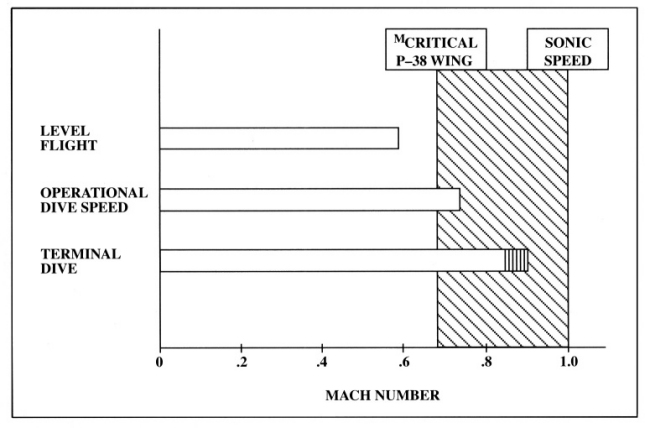 |
| Bar chart showing the magnitude of how much the P-38 penetrated the compressibility regime. |
steeper dive. This was called the "tuck-under" problem. It is important to note that the NACA soon solved this problem, using its expertise in compressibility effects. Although Lockheed consulted various aerodynamicists, including Theodore Von Kármán at Caltech, it turned out that John Stack at NACA Langley, with his accumulated experience in compressibility effects, was the only one to properly diagnose the problem. The wing of the P-38 lost lift when it encountered the compressibility burble. As a result, the downwash angle of the flow behind the wing was reduced. This in turn increased the effective angle of attack of the flow encountered by the horizontal tail, increasing the lift on the tail, and pitching the P-38 to a progressively steepening dive totally beyond the control of the pilot. Stack's solution was to place a special flap under the wing, to be employed only when these compressibility effects were encountered. The flap was not a conventional dive flap intended to reduce the speed. Rather, Stack's idea was to use the flap to maintain lift in the face of the compressibility burble, hence eliminating the change in the downwash angle, and therefore allowing the horizontal tail to function properly. This is a graphic example of how, in the early days of high-speed flight, the NACA compressibility research was found to be vital as real airplanes began to sneak up on Mach one.36
Indeed, it was time for real airplanes to be used to probe the mysteries of the unknown transonic gap. It was time for the high-speed research airplane to become a reality. The earliest concrete proposal along these lines was made by Ezra Kotcher, a senior instructor at the Army Air Corps Engineering School at Wright Field (a forerunner of today's Air Force Institute of Technology). Kotcher was a 1928 graduate of the University of California,
36. The "tuck-under" problem, and its technical Solution, is described in John D. Anderson, Jr., Introduction to Flight (New York, NY. McGraw-Hill Book Co., 3rd ed., 1989), pp. 406-08.
FROM ENGINEERING SCIENCE TO BIG SCIENCE 85
Berkeley, with a B.S. degree in mechanical engineering. The same year that John Stack first walked through the gates of Langley as a junior aeronautical engineer, Kotcher first walked into the Air Corps Wright Field, also as a junior aeronautical engineer. These two engineers were contemporary with each other, and both had a driving interest in high-speed aerodynamics. The careers of these two people would come together for the development of the Bell X-1 in the 1940s. Kotcher's proposal, drafted during the period May-August 1939, was a response to Major General Henry H. "Hap" Arnold's request for an investigation of advanced military aircraft in the future. The proposal contained a plan for a high-speed flight research program. Kotcher pointed out the unknown aspects of the transonic gap, and the problems associated with the compressibility burble as elucidated by the NACA, and concluded that the next important step was a full-scale flight research program.37 The Army Air Corps did not immediately respond to this proposal.
Meanwhile, back at Langley, the idea of a high-speed research airplane was gaining momentum. By the time the United States entered World War II in December 1941, John Stack had studied the behavior of the flow in wind tunnels when the flow in the test section was near or at Mach one. He found that when a model was mounted in the flow, the flow field in the test section essentially broke down, and any aerodynamic measurements were worthless. He concluded that the successful development of such transonic wind tunnels was a problem of Herculean proportions, and was far into the future. In order to learn about the aerodynamics of transonic flight, the only recourse appeared to be a real airplane that would fly in that regime. Therefore, during several visits by Dr. George Lewis, NACA's Director of Aeronautical Research, Stack seized the opportunity to mention the idea. Lewis, who liked Stack and appreciated the talent he brought to the NACA, was not immediately partial to the idea of a research airplane. But in early 1942, he left a crack in the door. In Hansen's words: "He left Stack with the idea, however, that some low-priority, back-of-the-envelope estimates to identify the most desirable design features of a transonic airplane could not hurt anyone, providing they did not distract from more pressing business."38
Given Stack's driving personality, this was all that was needed. With
the blessing of the local management at Langley, Stack immediately formed
a small group of engineers, and started to work on the preliminary design
aspects of a transonic research airplane. By the summer of 1943, the group
had produced such a design. Its principal features are listed below. This
design established a mind-set for John Stack that guided NACA thinking
on the transonic research airplane for the next five years a mind-set
that was to clash with the later ideas coming from Kotcher and the Army.
The NACA design:
37. Kotcher's role in the development of the high-speed research airplane is nicely presented by Hallion in Supersonic Flight, starting with p.12, and continuing throughout the book. As stated in note 1 above, Hallion's book is still today the most definitive source on the circumstances leading to the Bell X-1.
38. Hansen, Engineer in Charge, p. 259.
86 RESEARCH IN SUPERSONIC FLIGHT AND THE BREAKING OF THE SOUND BARRIER
The important goal was aerodynamic data at high subsonic speeds, not necessarily to fly into the supersonic regime. These features became [almost] a magna carta to Langley engineers, and to John Stack in particular.
The exigencies of wartime greatly accelerated research into high-speed aerodynamics; compressibility problems now had the attention not only of the NACA, but also of the Army and Navy as well. Stack, who had risen to be Eastman Jacob's Assistant Section Chief of the Variable Density Tunnel in 1935, and Head of the High-Speed Wind Tunnels in 1937, was made Chief of the newly formed Compressibility Research Division in 1943.39 Stack now had his most influential position to date to push for the high-speed research airplane.
The Bell X-1: Point and Counterpoint
Although the NACA had the compressibility knowledge and technology, the Army and Navy had the money that would be necessary for the design and building of a research airplane. So it was appropriate that the Bell X-1 was conceived during a fateful visit by Robert J. Woods of Bell Aircraft to the office of Ezra Kotcher on 30 November 1944. Woods, who had NACA ties because he had worked at Langley during 1928-1929 in the Variable Density Tunnel, had joined with Lawrence D. Bell in 1935 to form the Bell Aircraft Corporation in Buffalo, New York. That day in November, Woods had dropped by Kotcher's office simply to chat. During the conversation, Kotcher relayed the information that the Army, with the help of the NACA, desired to build a special, non-military high-speed research airplane. After detailing the Army's specifications for the aircraft, Kotcher asked Woods if the Bell Corporation was interested in designing and building the airplane. Woods said yes. The die was cast.40
When Kotcher had been talking with Woods, he was operating with some authority. During 1944, Army and NACA engineers had been meeting to outline the nature of a joint research airplane program. Moreover, by mid-1944, Kotcher had received the Army's approval for the design and acquisition of such an airplane. However, the Army's concept of the high-speed research airplane was somewhat different than that of NASA. To understand this difference, we have to examine two situations in existence at the time
The first situation was that of a common, public belief in the "sound barrier." The myth of the sound barrier had its beginning in 1935, when the British aerodynamicist W. F. Hilton was explaining to a newsman about some of the high-speed experiments he was conducting at the National Physical Laboratory. Pointing to a plot of airfoil drag, Hilton said: "See how the resistance of a wing shoots up like a barrier against higher speed as we approach the speed of sound." The next morning, the leading British newspapers were misrepresenting Hilton's comment by referring to "the sound barrier."41 The idea of a physical barrier to flight that airplanes could never fly faster than the speed of sound became widespread among the public. Furthermore, even though most engineers knew differently, they still had uncertainty in just how much the drag would increase in the transonic regime, and given the low thrust levels of airplane powerplants at that time, the speed of sound certainly loomed as a tremendous mountain to climb.
39. Official NASA biographical and job description summary From the John Stack files, Langley Historical Archives.
40. Hallion, Supersonic Flight, p. 34.
41. W.F. Hilton, "British Aeronautical Research Facilities," Journal of the Royal Aeronautical Society 70 (Centenary Issue, 1966): 103-104.
FROM ENGINEERING SCIENCE TO BIG SCIENCE 87
The second situation that colored the Army's thinking at that time was local, namely that Kotcher was convinced that the research airplane must be powered by a rocket engine rather than a turbojet. This stemmed from his experience in 1943 as project officer on the proposed Northrop XP-79 rocket-propelled flying wing interceptor, as well as the knowledge within the Army of' Germany's new rocket-propelled interceptor, the ME-163.
All of these were in conflict with the NACA's more careful and scientific
approach. However, the Army was paying for the X-1, and the Army's views
prevailed.
Although John Stack and the NACA did not agree with the Army's specifications, they nevertheless provided as much technical data as possible throughout the design of the X-1. Lacking appropriate wind tunnel data and theoretical solutions for transonic aerodynamics, the NACA developed three stopgap methods for the acquisition of transonic aerodynamic data. In 1944, Langley carried out tests using the drop-body concept. Wings were mounted on bomb-like missiles which were dropped from a B-29 at an altitude of 30,000 feet. The terminal velocities of these models sometimes reached supersonic speeds. The data were limited, mainly consisting of estimates of the drag, but NACA engineers considered it reliable enough to estimate the power required for a transonic airplane. Also in 1944, Robert R. Gilruth, Chief of the Flight Research Section, developed the wing-flow method, wherein a model wing was mounted perpendicular at just the right location on the wing of a P-51D. In a dive, the P-51 would pick up enough speed, to about Mach 0.81, that locally supersonic flow would occur over its wing. The small wing model mounted perpendicular on the P-51 wing would be totally immersed in this supersonic flow region, providing a unique high-speed flow environment for the model. Ultimately, these wing-flow tests provided the NACA with the most systematic and continuous plots of transonic data yet assembled.42 The third stopgap method was rocket-model testing. Here, wing models were mounted on rockets, which were fired from the NACA's facility at Wallops Island on the coast of Virginia's Eastern Shore. The data from all these methods, along with the existing core of compressibility data obtained by the NACA over the past 20 years as described in the earlier sections of this chapter, constituted the scientific and engineering base from which the Bell Aircraft Corp. designed the X-1.
Finally, we note that the NACA was responsible for the instrumentation that was housed inside the Bell X-1 This instrumentation and its location on the X-1 is illustrated on page 84. This is an example of one of those unseen aspects of technology upon which the acquisition of historic data depends. It is fitting that the NACA excelled in both aspects of the X-1 concept the external configuration and the essential instruments mounted inside for the acquisition of quantitative knowledge.
42. Hansen, Engineer in Charge, p. 267.
88 RESEARCH IN SUPERSONIC FLIGHT AND THE BREAKING OF THE SOUND BARRIER
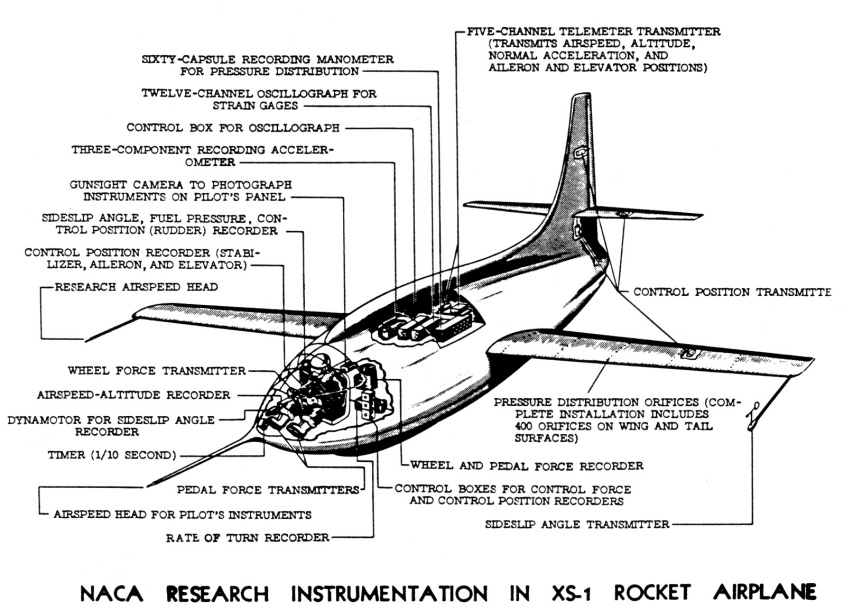 |
| Schematic of the instrumentation mounted by the NACA in the Bell X-1. |
Breaking the Sound Barrier
We began this chapter by transporting ourselves back to October 14, 1947, and riding with Chuck Yeager as he flew the Bell X-1 through the sound barrier, becoming the first human to fly faster than sound. The detailed events of 1946 and 1947 that finally resulted in this flight the design, construction and early flight testing program by Bell, and the Army's intense preparations for the handling of the X-1 at Muroc are nicely related by historians Richard P. Hallion and James O. Young.43 Nothing is served by repeating them here. Rather, we return to the purpose of this chapter as stated in the introductory paragraphs. The first supersonic flight of the Bell X-1 represented the culmination of 260 years of research into the mysteries of high-speed aerodynamics. It was especially the fruition of 23 years of insightful research in high-speed aerodynamics by the NACA research that represents one of the most important stories in the history of aeronautical engineering.
43. Hallion, Supersonic Flight, James O. Young, Supersonic Symposium: The Men of Mach I (Edwards Air Force Base, CA: Air Force Flight Test Center History Office, September 1990), pp. 1-89.
FROM ENGINEERING SCIENCE TO BIG SCIENCE 89
On December 17, 1948, President Harry S. Truman presented the thirty-seven-year-old Collier Trophyjointly to three men for "the greatest aeronautical achievement since the original flight of the Wright Brothers' airplane."44 The Trophy, officially the Collier Trophy for the year 1947, was the highest possible official recognition for the accomplishments embodied in the X-1. The announcement page from the December 25, 1948 issue of Collier's magazine is shown on page 86. Properly, John Stack was one of the three men, recognized as the scientist, along with Lawrence D. Bell, the manufacturer, and Captain Charles E. Yeager, the pilot. The citation to Stack read: "for pioneering research to determine the physical laws affecting supersonic flight and for his conception of transonic research airplanes." A major purpose of this chapter was to bring meaning to this citation so much is hidden in these few words.45 Unseen in this photograph, but present in spirit, is the team of NACA researchers who also worked towards determining the physical laws affecting supersonic flight, and to conceptualize the transonic research airplane. In this sense, the 1947 Collier Trophy was a "global" award to the entire NACA high-speed research program.
The 1947 Collier Trophy was also a recognition of the role of engineering science in the ultimate success of the Bell X-1. Note that in the award John Stack is explicitly recognized as a scientist (not an engineer). This is somewhat of a misnomer Stack was performing as an engineering scientist in this activity, neither a pure scientist nor a pure engineer. The NACA had provided all the elements that allowed this engineering science contribution to occur.
At the time of this award, John Stack was Assistant Chief of Research at NACA Langley. In 1952, he was made Assistant Director of Langley. By that time he had been awarded his second Collier Trophy, the 1951 Trophy, for the development of the Slotted-Throat Wind Tunnel. In 1961, three years after the NACA was absorbed into the National Aeronautics and Space Administration, Stack became Director of Aeronautical Research at NASA Headquarters in Washington. Despairing of the de-emphasis of aeronautics in NASA, after thirty-four years of government service with the NACA and NASA, Stack retired in 1962 and became vice president for engineering for Republic Aircraft Corporation in Long Island. When Republic was absorbed by Fairchild Hiller in 1965, Stack was appointed a vice president of that company, retiring in 1971. On June 18, 1972, Stack fell from a horse on his farm in Yorktown, Virginia, and was injured fatally. He is buried in the churchyard cemetery of Grace Episcopal Church in Yorktown, only a few miles away from NASA's Langley Research Center. Today, F-15s from the nearby Langley Air Force Base fly over the churchyard airplanes that can routinely fly at almost three times the speed of sound, thanks to the legacy of John Stack and the NACA high-speed research program.
44. Collier's, December 25, 1948.
45. John Stack files, NASA Langley Archives.
90 RESEARCH IN SUPERSONIC FLIGHT AND THE BREAKING OF THE SOUND BARRIER
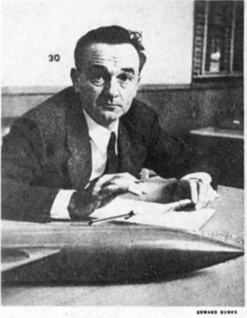 |
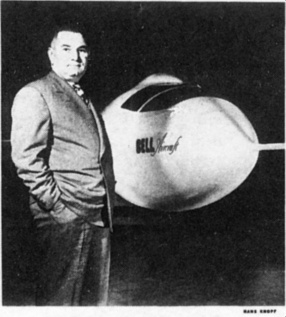 |
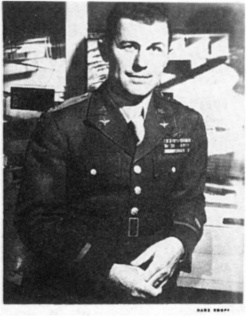 |
| SCIENTIST: John Stack, for the past 20 years government research scientist with the National Advisory Committee for Aeronautics, is the first of the three men who share the award of the Collier Trophy for the achievement of human supersonic flight. It was because of Stack's awareness of the absolute necessity for ever superior aircraft, and his intensive study of the problems of supersonic flight that a workable program for the construction of a research plane came into being. | MANUFACTURER: Lawrence D. Bell, president of Bell Aircraft Corporation, was awarded the contract by the Air Force to design and build the plane evolved from Stack's scientific presentation of supersonic flight. Bell has a reputation for taking on the unusual, the unconventional and what some call the impossible. The ship he designed and built was the Bell X-1 which, before delivery, was tested in 21 flights at a speed slightly less than the speed of sound. | PILOT: Captain Charles E. Yeager, USAF, was chosen from the nation's finest test-pilot talent as the man to fly the plane pioneered by Stack and built by Bell. Deemed "a natural airman, if there is such a thing," on October 14, 1947, Yeager became the first man to fly faster than the speed of sound. It is for the combined achievement of these three men in their successful penetration of the transonic barrier that the Collier Trophy for 1947 has been awarded. |
|
For Flight Beyond the Speed of Sound By FREDERICK R. NEELY For bringing about the achievement of human supersonic Flight, John Stack, Lawrence D. Bell and Captain Charles E. Yeager, USAF, win America's highest aviation award |
John Stack: career government research scientist of the National Advisory Committee for Aeronautics "for pioneering research to determine the physical laws affecting supersonic flight and for his conception of transonic research airplanes." Lawrence D. Bell, president of Bell Aircraft Corporation, "for the design and construction of the special research airplane X-1." Captain Charles E. Yeager. U.S. Air Force, "who, with that airplane, on October 14, 1947, first achieved human flight faster than sound." To those three men goes the honor of playing the major roles in an achievement which the Collier |
Trophy committee termed "the greatest since the first
successful flight of the original Wright Brothers' airplane."
All three have been outstanding in their contributions to the vitally important science of supersonic flight flight that is faster than sound, the speed of which at sea level, with a temperature of 59 degrees and in still air, is 761 miles an hour. However, at altitudes ranging between 40.000 and 100.000 feet. the speed of sound is reached at only 663 miles an hour. This is due to the fact that at such high altitudes the temperature is almost constantly 67 degrees below zero and sound travels more slowly in cold air. At just what altitude Capt. Yeager flew is as much of a secret as the actual supersonic speed he attained. The problem that confronted Stack, Bell and Yeager was not so much that of flying faster than sound as it was successful flying at speeds between 600 and 900 miles an hour the transonic range. Aeronautical scientists were in grave doubt as to just what took place when conventional aircraft entered the transonic range in high-speed dives. They knew that both plane and pilot were kicked around unmercifully for seconds that seemed like |
centuries and that both were completely out of control.
Badly and naturally frightened, the pilots were unable to bring back detailed
scientific reports on the phenomenon, and they were usually unwilling to
repeat their flights.
Wind tunnel tests with small-scale models revealed that the flow of air over a plane in the transonic range was partly subsonic and partly supersonic. Because of this. the conventional planes (usually fighter types) took on an extremely inconsistent and erratic behavior. But the tunnel findings were not conclusive and since supersonic tunnels large enough to mount a full-scale airplane are prohibitive in cost the scientists concluded they needed a special research airplane equipped with instruments capable of measuring and automatically recording all of the forces acting upon an airplane in transonic flight. This was where John Stack came in. It was natural that be should have conducted the research phase for he had been working on the fundamental problems of high-speed flight in the wind tunnels and laboratories of the NACA at Langley Field, Virginia, since 1929. shortly after he had joined the government's great aeronautical research es- Collier's for December 25. 1948
|
The first page of the Collier's magazine announcement of the winners
of the 1947 Collier Trophy, December 25,1948.